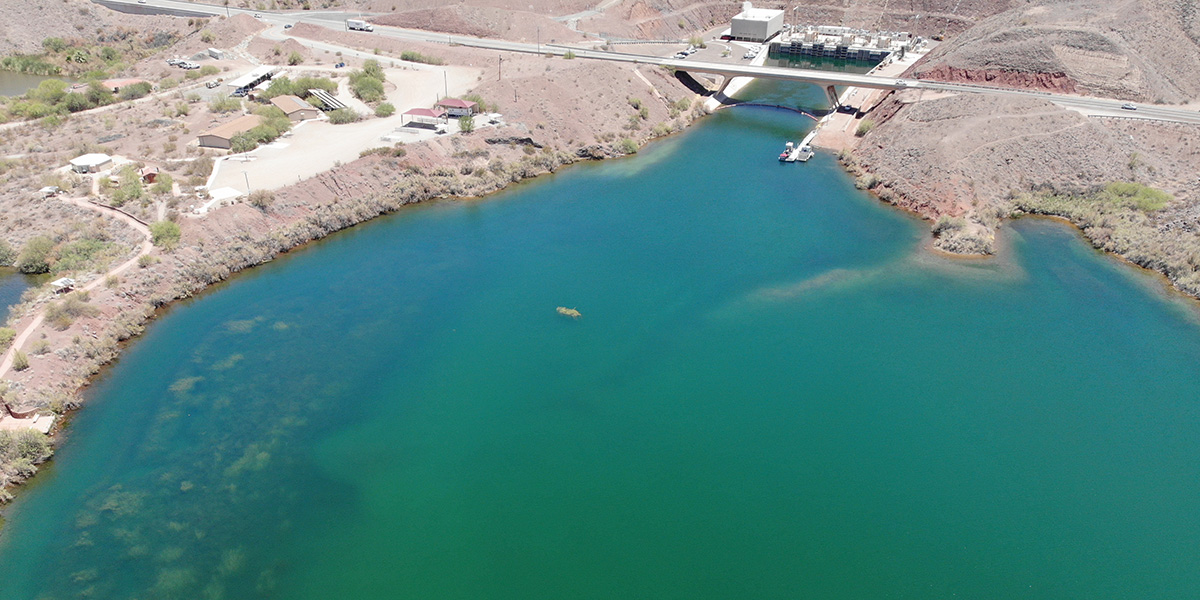Each summer, nature rolls out a “special” welcome mat: large mats of weeds that can impede the flow of water into the CAP system.
Aquatic vegetation in the Colorado River (Lake Havasu) starts to grow in CAP’s 65-acre intake channel in late April each year. The intake channel is where water enters the first plant on CAP’s system, Mark Wilmer Pumping Plant. By the mid-July, weeds begin to reach the end of their growing cycle and start to die, often uprooting or breaking free and floating to the water surface. This dead/detached vegetation clumps together, forming large mats that move around the lake based on wind, weather, and water current. These weed mats have the potential to not only impede the flow of water, but also clog critical pumps and other critical infrastructure.
You may wonder how a few weeds can cause so much concern for a system as massive as CAP; however, these are not your average weeds, and they are a formidable foe. And, for nearly 15 years, CAP has been addressing the challenge to ensure the weeds don’t disrupt reliable water deliveries. In 2022, it has expanded to be a multi-faceted approach.
Since 2008, CAP has been mechanically removing vegetation from the intake channel using weed harvesting boats and long-reach excavators. CAP crews work diligently to intercept weeds before they reach the pumping plant. This is no easy task, as mats can form with a surface area of greater than two acres. Additionally, the weeds grow to a height of nearly 20 feet, so they become quite an entangled mess when they form these mats. And the weight of this mass of weeds means that crews can only collect a small amount in each trip. CAP’s newest weed boat includes a “cutter” which helps to better manage these large mats.
Although our crews are on-call 24/7 during weed season, there is occasion when the mats are able to get near the pumping plant. In these situations, a long-reach excavator is used from the deck of the pumping plant to remove the vegetation and ensure the continued flow of water.
In 2012, CAP began using advanced sonar technology to map vegetation within the intake channel and gain a better understanding of patterns in weed growth within the lake. From this data, we can pinpoint where our greatest challenges lie, better plan for weed removal activities, and determine the timing of peak weed mat formation.
CAP has also engaged in a number of pilot projects using appropriate herbicides to target areas identified with sonar mapping that are especially problematic. These spot treatments have reduced the burden on our weed collection crews, allowing them to stay ahead of the majority of the floating weed mats.
Lastly, CAP brings in a special guest to take care of aquatic vegetation growth within the canal itself – Grass Carp. The large minnows (yes, minnow) have a voracious appetite for greens, grow to weights in excess of 40 pounds in the canal, and can eat 2-3 times their body weight each day! Although these fish are used throughout the United States for vegetation control, they are an invasive species, so only sterile, non-reproducing fish (triploid) can be stocked. They also must have a head width greater than 2.5 inches so that they cannot travel to different sections of the canal. Due to their propensity to displace native fish and sport fish populations, they are strictly forbidden to be stocked into the Colorado River and its reservoirs.
We haven’t won the war, but we are continuing to win the battles, ensuring the reliability of CAP’s water delivery system.
KRA: Project Reliability
Providing reliable and cost-effective operations, maintenance, and replacement of CAP infrastructure and technology assets



